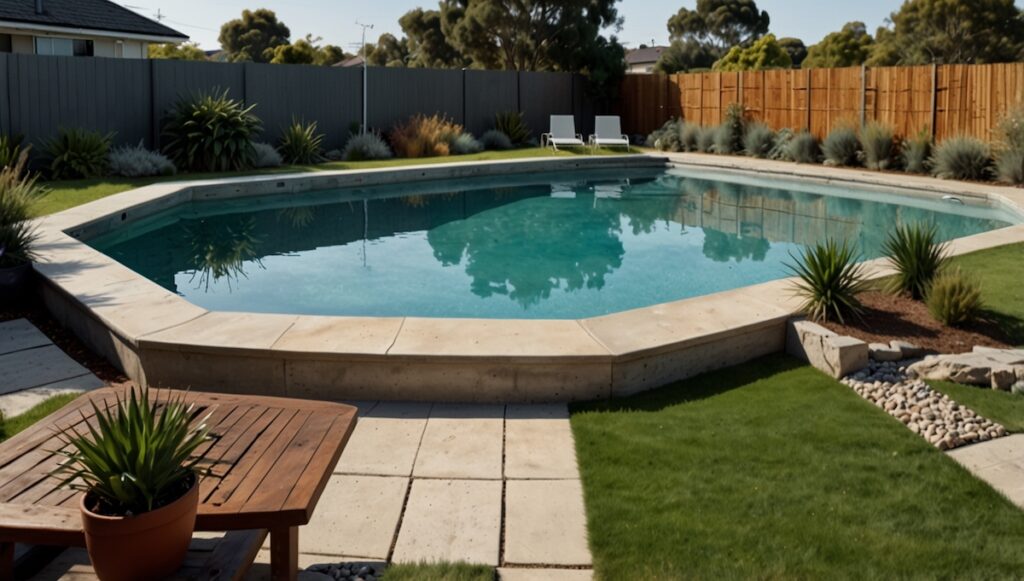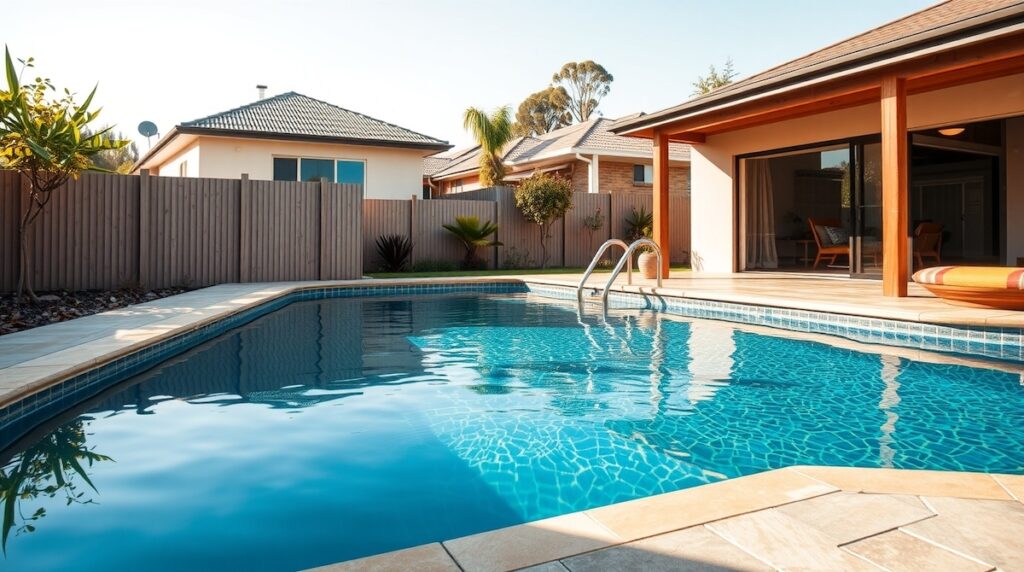When planning a pool in Melbourne, many homeowners start with generic price estimates — only to discover that the actual costs can vary dramatically based on local conditions. Understanding what truly drives pool construction costs here means looking beyond broad figures and focusing on the specific factors that shape each project.
In Melbourne, the final price of a pool depends on technical choices such as materials and heating systems, the challenges of your site (from flat suburban blocks to sloping inner-city lots), and the approvals required by local councils. A realistic budget reflects these local realities rather than vague national averages — particularly in high-cost areas like Brighton, Camberwell, or Malvern
Why Pool Costs Vary So Much in Melbourne
Pool construction costs in Melbourne are shaped by a unique mix of factors that go far beyond the choice of pool type. The city’s varied terrain — from flat suburban lots to sloped or clay-heavy inner areas — directly impacts site preparation and engineering needs.
Local council regulations also play a role, with certain suburbs imposing stricter planning or environmental requirements that can add to the budget. Access for machinery, availability of skilled contractors, and seasonal demand fluctuations further influence pricing. As a result, no two pool projects in Melbourne cost the same — even if they look similar on paper.
Base Construction Costs: What You’re Really Paying For
Understanding base construction costs helps demystify what goes into the price of a pool in Melbourne. These core expenses reflect the work and challenges unique to your site.
Excavation and site preparation (flat vs. sloped lots)
Flat lots typically require straightforward excavation, keeping costs relatively low. Sloped or uneven blocks — common in Melbourne’s inner and eastern suburbs — demand more complex earthworks, retaining structures, and engineered solutions, significantly increasing the budget.
Concrete vs. fibreglass: not just a material difference
Deciding if fibreglass or concrete is what’s best for Melbourne projects depends on your priorities, and this choice is about more than just materials—it directly impacts cost. Concrete pools allow custom shapes but involve longer build times and higher labour costs, while fibreglass pools are faster to install but offer less design flexibility.
Engineering and permit fees (especially inner suburbs)
Engineering reports and soil tests are often mandatory, but understanding which council permits you need for a pool is a key part of the budget. Permit fees vary by suburb, with inner-city areas often requiring additional planning approvals that add to the total costs.
Access restrictions and machinery delivery
The practical challenges of knowing how to install a pool on a narrow block or a property with limited side access can drive up costs significantly. These situations often require specialised machinery, crane hire, or manual labour for material delivery and removal.
Real Cost Differences by Pool Type (in a Melbourne Context)
Melbourne homeowners typically weigh two main options when budgeting for a new pool — each with distinct cost profiles. Entry-level fibreglass pools are commonly seen in middle-ring suburbs, but prices rise quickly depending on finishes. On the other hand, costs vary drastically depending on suburb profiles

Entry-level fibreglass pools for middle-ring suburbs
In Melbourne’s middle-ring suburbs, fibreglass pools are a popular choice for their predictable pricing and quick installation. Basic models can start at a lower price point, but costs rise with added features like upgraded coping, heating, or integrated spas. Access challenges and soil conditions can also push costs beyond the base estimate.
Custom concrete pools in Brighton, Kew and Toorak
In high-end suburbs such as Brighton, Kew, and Toorak, custom concrete pools dominate. These pools are tailored to suit complex sites, architectural styles, and luxury finishes. The price reflects this customisation, with budgets often two to three times higher than for a standard fibreglass pool, depending on design and site complexity.
The “Extras” That Add Thousands to Melbourne Pool Projects
Beyond the base price, many Melbourne pool projects see costs climb due to optional features and finishes — some essential, others aesthetic.
Tiling, coping, fencing and decking
High-quality tiling and coping not only improve durability but also enhance visual appeal. In Melbourne, fencing is mandatory for safety compliance, with styles and materials influencing the final price. Extensive decking, particularly with premium materials, can add significantly to overall costs.
Heating systems: gas vs. solar vs. hybrid
Considering if Melbourne’s climate is suitable for a pool without heating is a key question, which is why most projects include a heating system. Gas offers fast results but higher running costs. Solar systems are eco-friendly and cost-effective over time, though they involve higher initial investment. Hybrid systems combine both for greater flexibility, adding to upfront costs.
Landscaping integration and local soil stabilisation
Integrating the pool with existing gardens or creating new landscaping can add substantial cost — especially when soil stabilisation is needed on challenging sites. This is common in areas with clay or sandy soils prone to shifting.
Suburb-Based Cost Variations: North vs. East vs. Coastal
Where you build in Melbourne has a major impact on pool construction costs, with geography and local conditions driving price differences.
Pricing pressure in Glen Iris, Malvern and Camberwell
In these eastern suburbs, high demand for pools and limited contractor availability often push prices up. Smaller lot sizes and heritage overlays can add complexity, requiring more planning and custom solutions that increase costs.
Coastal conditions and engineering in Brighton, Beaumaris
Coastal suburbs face additional challenges. Pools in Brighton and Beaumaris often need extra engineering to handle sandy soils, high water tables, and salt exposure. These requirements contribute to higher construction and maintenance costs.
Soil instability and cost inflation in inner-north areas (e.g. Brunswick)
Brunswick and nearby inner-north suburbs sit on clay-rich soils that expand and contract with moisture levels. Pools in these areas require specialised footings or soil stabilisation, adding significant cost to both installation and long-term upkeep.
When and How to Build to Reduce Costs
Smart timing and planning can help Melbourne homeowners control pool construction costs without compromising quality.

Seasonal labour availability and price drops
Building during off-peak periods — typically late autumn and winter — can secure better rates. Labour demand is lower, and contractors may offer discounts to fill their schedule during quieter months.
Combining permits with broader renovations
If you’re planning other home improvements, combining pool construction permits with overall renovation approvals can reduce administrative fees and streamline compliance processes. This approach also helps minimise disruption and site preparation costs.
Frequently Asked Questions (FAQ)
What’s the cheapest way to build a pool in Melbourne without sacrificing quality?
Choosing a standard-size fibreglass pool on a flat, easily accessible block offers the best balance of affordability and durability. Limiting extras like extensive decking or custom water features also helps control costs.
Do permits and approvals really change the total cost depending on the suburb?
Yes — permit costs and approval complexity vary by suburb. Inner-city areas or those with heritage overlays often require more documentation and compliance steps, which can add to both time and budget.
Is it true that costs are higher in Brighton and Toorak than in other areas?
Typically, yes. These premium suburbs often involve larger, custom-designed pools with luxury finishes and complex engineering to suit high-value properties, which increases overall cost.
How much should I expect to pay for fencing and compliance in Melbourne?
Fencing is mandatory and costs depend on materials, design, and site conditions. For most Melbourne properties, homeowners should budget several thousand dollars for compliant fencing and required certifications.
The true cost of building a pool in Melbourne depends on a mix of factors: your site’s conditions, the construction type you choose, the suburb’s specific requirements, and the level of finish you want. It’s not just about setting a budget — it’s about striking the right balance between technical choices, local adaptation, and overall project strategy.
For a more detailed breakdown of typical costs across key components, homeowners can consult resources like “Average Cost of Building a Pool in Melbourne” to plan with greater confidence.
